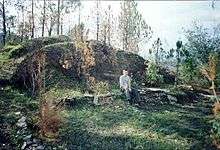Kasar Devi
Kasar Devi is a village near Almora, Uttarakhand. It is known for the Kasar Devi temple, a Devi temple, dedicated to Kasar Devi, after whom the place is also named. The temple structure dates to the 2nd century CE. Swami Vivekananda visited Kasar Devi in 1890s, and numerous western seeker, Sunyata Baba Alfred Sorensen and Lama Anagarika Govinda. A place also known for Crank's Ridge, just outside the village, which was popular destination during the Hippie movement of the 1960s and 1970s, and continues to attract trekkers and tourists, both domestic and foreign.
The temple hosts the annual "Kasar Devi Fair" on Kartik Poornima (November–December).
History

Kasar Devi first became known when in the 1890s, Swami Vivekananda visited and meditated here and has mentioned his experience in his diaries.[1] Walter Evans-Wentz, a pioneer in the study of Tibetan Buddhism, who later translated The Tibetan Book of the Dead, stayed here for some time.[2]
Then in the 1930s, Danish mystic Sunyata Baba (Alfred Sorensen) came here and lived here the over three decades, as did Ernst Hoffman, who became Tibetan Buddhist Lama Anagarika Govinda and Li Goutami. This led to a series of spiritual seekers from the west, visiting them. In 1961, Govinda was visited by Beat poets, Allen Ginsberg, Peter Orlovsky and Gary Snyder.[2][3] In later history, at the peak of the Hippie movement, the area also became a part of the Hippie trail. Crank's Ridge, colloquially known as Hippie Hill, which lies ahead of Kasar Devi became a popular destination. It became home to several bohemian artists, writers and western Tibetan Buddhists, and even visited by mystic-saint Anandamayi Ma. The ridge got its name amongst hippy circles, after American psychologist Timothy Leary streaked here in the 1960s. Leary wrote majority of his ‘psychedelic prayers’ here. Thus, through the 1960 and 1970s, the area was visited by personalities of the counter-culture, Bob Dylan, George Harrison and Cat Stevens, Western Buddhist Robert Thurman, and writer D. H. Lawrence, who spent two summers here.[1][4]
Kasar Devi temple
The village is mainly known for the Kasar Devi temple, the shrine dedicated to Kasar Devi. The temple itself, dates back to the 2nd century CE. A winding walkway from gateway on the main road, right the beginning of the village, leads up to the temple.
The area is home to deodar and pine forests. It also provides views not just of Almora and the Hawabagh Valley, but also of the panoramic view of the Himalayas from Bandarpunch peak on the Himachal Pradesh border to Api Himal in Nepal.[4][5]
A large fair, known as Kasar Devi Fair, is held at the Kasar Devi temple on the occasion of Kartik Poornima in the Hindu calendar, corresponding to November and December.[6]
This temple has been found to be of special importance because the region around this temple has enormous geomagnetic field. This is because this temple comes under the Van Allen Belt. The causes behind the formation of this belt have been researched by NASA for the last two years. Two other famous places which have been found to have similar high magnetic field (Van Allen Belt) are Machu Picchu in Peru and Stonehenge in England.
People who have meditated at Kasar Devi have expressed a degree of higher rejuvenation and have attached special importance to it.
(Translated from http://m.aajtak.in/story.jsp?sid=832203)
Overview
Kasar Devi is situated on a hilltop, on the edge of a ridge off the Almora-Bageshwar highway on the Kaashay hills of Kumaon Himalayas. As it is situated above the ridge of Almora town, it is accessible through eight-km hike from Almora or 10 km by road.[1] One km away is the village of Kalimath popular with tourists. Also close by is the Binsar Wildlife Sanctuary, which lies 30 km away.[7]
References
- 1 2 3 Siddhartha Sen (10 March 2013). "Trekking to a Himalayan hill that Dylan loved and Vivekananda called home". MiD DAY. Retrieved 2013-08-30.
- 1 2 Bill Aitken (2003). Footloose in the Himalaya. Orient Blackswan. pp. 47–. ISBN 978-81-7824-052-7. Retrieved 30 August 2013.
- ↑ Donald S. Lopez (1 May 1999). Prisoners of Shangri-La: Tibetan Buddhism and the West. University of Chicago Press. pp. 61–. ISBN 978-0-226-49311-4. Retrieved 30 August 2013.
- 1 2 Anurag Mallick; Priya Ganapathy (12 February 2012). "In the woods of gods". Deccan Herald. Retrieved 2013-08-30.
- ↑ Meera Joshi (14 December 2007). "Dev trail of Kumaon". The Hindu, Business Line. Retrieved 2013-08-30.
- ↑ Purnima S. Tripathi (25 February – 10 March 2006). "A tourist's paradise". The Hindu, Frontline. Retrieved 2013-08-30.
- ↑ "Don't Miss: Kasar Devi, a piece of paradise". Rediff Getahead. 30 March 2013. Retrieved 2013-08-30.